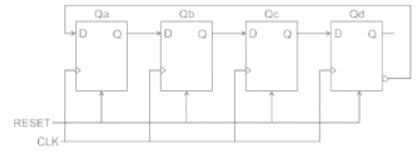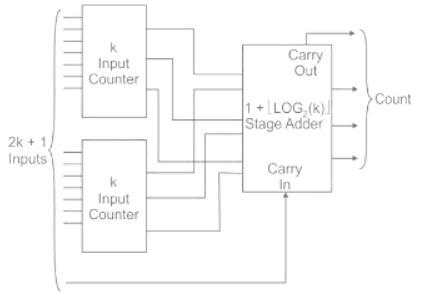Electrical Engineering (EE) Exam > Electrical Engineering (EE) Questions > A Shift register in which the output of the l...
Start Learning for Free
A Shift register in which the output of the last flip-flop is connected to the input of the first flip-flop
- a)BCD counter
- b)Parallel counter
- c)Ripple counter
- d)Ring counter
Correct answer is option 'D'. Can you explain this answer?
Most Upvoted Answer
A Shift register in which the output of the last flip-flop is connecte...
Ring Counter:
A ring counter is a type of shift register in which the output of the last flip-flop is connected to the input of the first flip-flop, creating a circular or ring-like structure. This arrangement allows the data to circulate through the flip-flops, creating a sequence of states.
Working Principle:
The ring counter operates by shifting the data bit through the flip-flops in a circular manner. Initially, all the flip-flops are reset, and only one flip-flop is set to 1. As the clock pulses are applied, the 1-bit moves from one flip-flop to the next in a cyclic pattern until it returns to the first flip-flop, completing one cycle.
Advantages of a Ring Counter:
1. Simple Design: Ring counters have a simple and straightforward design, making them easy to implement.
2. Efficient Use of Flip-Flops: Ring counters require fewer flip-flops compared to other types of counters, making them more cost-effective.
3. Fast Operation: Since the data circulates through the flip-flops, the output changes quickly with each clock pulse, resulting in fast operation.
Applications:
Ring counters find applications in various areas, including:
1. Frequency Division: They are used in frequency dividers to divide the clock frequency by a specific factor.
2. Timing Generation: Ring counters can be used to generate timing signals or sequences in digital systems.
3. Data Encryption: They are used in certain encryption algorithms to generate pseudorandom numbers.
Comparison with Other Counters:
- BCD Counter: A BCD counter is a type of counter that counts in binary-coded decimal format. It does not have a circular structure like a ring counter.
- Parallel Counter: A parallel counter is a type of counter that counts in parallel, with each flip-flop representing a specific bit. It does not have a circular structure like a ring counter.
- Ripple Counter: A ripple counter is a type of counter in which the output of one flip-flop serves as the clock input for the next flip-flop. It does not have a circular structure like a ring counter.
Overall, a ring counter is a specific type of shift register that has a circular structure, allowing the data to circulate through the flip-flops. It finds applications in various areas and offers advantages such as simplicity, efficient use of flip-flops, and fast operation.
A ring counter is a type of shift register in which the output of the last flip-flop is connected to the input of the first flip-flop, creating a circular or ring-like structure. This arrangement allows the data to circulate through the flip-flops, creating a sequence of states.
Working Principle:
The ring counter operates by shifting the data bit through the flip-flops in a circular manner. Initially, all the flip-flops are reset, and only one flip-flop is set to 1. As the clock pulses are applied, the 1-bit moves from one flip-flop to the next in a cyclic pattern until it returns to the first flip-flop, completing one cycle.
Advantages of a Ring Counter:
1. Simple Design: Ring counters have a simple and straightforward design, making them easy to implement.
2. Efficient Use of Flip-Flops: Ring counters require fewer flip-flops compared to other types of counters, making them more cost-effective.
3. Fast Operation: Since the data circulates through the flip-flops, the output changes quickly with each clock pulse, resulting in fast operation.
Applications:
Ring counters find applications in various areas, including:
1. Frequency Division: They are used in frequency dividers to divide the clock frequency by a specific factor.
2. Timing Generation: Ring counters can be used to generate timing signals or sequences in digital systems.
3. Data Encryption: They are used in certain encryption algorithms to generate pseudorandom numbers.
Comparison with Other Counters:
- BCD Counter: A BCD counter is a type of counter that counts in binary-coded decimal format. It does not have a circular structure like a ring counter.
- Parallel Counter: A parallel counter is a type of counter that counts in parallel, with each flip-flop representing a specific bit. It does not have a circular structure like a ring counter.
- Ripple Counter: A ripple counter is a type of counter in which the output of one flip-flop serves as the clock input for the next flip-flop. It does not have a circular structure like a ring counter.
Overall, a ring counter is a specific type of shift register that has a circular structure, allowing the data to circulate through the flip-flops. It finds applications in various areas and offers advantages such as simplicity, efficient use of flip-flops, and fast operation.
Free Test
FREE
| Start Free Test |
Community Answer
A Shift register in which the output of the last flip-flop is connecte...
The Ring shift counter is a recirculating register in which the serial output is connected back to the serial input as shown:

A Straight ring counter with ‘n’ flip-flops will have n states.
Important Points
Johnson Counter:

A Straight ring counter with ‘n’ flip-flops will have n states.
Important Points
Johnson Counter:
A Johnson counter is a modified ring counter, where the inverted output from the last flip flop is connected to the input to the first.
The MOD of the Johnson counter is 2n if n flip-flops are used.
The circuit diagram for a 4-bit Johnson Counter is as shown:

Ripple Counter:

Ripple Counter:
A ripple counter is an asynchronous counter where only the first flip-flop is clocked by an external clock.
All subsequent flip-flops are clocked by the output of the preceding flip-flop

Parallel Counter:

Parallel Counter:
A parallel counter is a combinational logic circuit that receives a set of binary count signals in parallel and determines the final count after some fixed delay.



|
Explore Courses for Electrical Engineering (EE) exam
|

|
Question Description
A Shift register in which the output of the last flip-flop is connected to the input of the first flip-flopa)BCD counterb)Parallel counterc)Ripple counterd)Ring counterCorrect answer is option 'D'. Can you explain this answer? for Electrical Engineering (EE) 2025 is part of Electrical Engineering (EE) preparation. The Question and answers have been prepared according to the Electrical Engineering (EE) exam syllabus. Information about A Shift register in which the output of the last flip-flop is connected to the input of the first flip-flopa)BCD counterb)Parallel counterc)Ripple counterd)Ring counterCorrect answer is option 'D'. Can you explain this answer? covers all topics & solutions for Electrical Engineering (EE) 2025 Exam. Find important definitions, questions, meanings, examples, exercises and tests below for A Shift register in which the output of the last flip-flop is connected to the input of the first flip-flopa)BCD counterb)Parallel counterc)Ripple counterd)Ring counterCorrect answer is option 'D'. Can you explain this answer?.
A Shift register in which the output of the last flip-flop is connected to the input of the first flip-flopa)BCD counterb)Parallel counterc)Ripple counterd)Ring counterCorrect answer is option 'D'. Can you explain this answer? for Electrical Engineering (EE) 2025 is part of Electrical Engineering (EE) preparation. The Question and answers have been prepared according to the Electrical Engineering (EE) exam syllabus. Information about A Shift register in which the output of the last flip-flop is connected to the input of the first flip-flopa)BCD counterb)Parallel counterc)Ripple counterd)Ring counterCorrect answer is option 'D'. Can you explain this answer? covers all topics & solutions for Electrical Engineering (EE) 2025 Exam. Find important definitions, questions, meanings, examples, exercises and tests below for A Shift register in which the output of the last flip-flop is connected to the input of the first flip-flopa)BCD counterb)Parallel counterc)Ripple counterd)Ring counterCorrect answer is option 'D'. Can you explain this answer?.
Solutions for A Shift register in which the output of the last flip-flop is connected to the input of the first flip-flopa)BCD counterb)Parallel counterc)Ripple counterd)Ring counterCorrect answer is option 'D'. Can you explain this answer? in English & in Hindi are available as part of our courses for Electrical Engineering (EE).
Download more important topics, notes, lectures and mock test series for Electrical Engineering (EE) Exam by signing up for free.
Here you can find the meaning of A Shift register in which the output of the last flip-flop is connected to the input of the first flip-flopa)BCD counterb)Parallel counterc)Ripple counterd)Ring counterCorrect answer is option 'D'. Can you explain this answer? defined & explained in the simplest way possible. Besides giving the explanation of
A Shift register in which the output of the last flip-flop is connected to the input of the first flip-flopa)BCD counterb)Parallel counterc)Ripple counterd)Ring counterCorrect answer is option 'D'. Can you explain this answer?, a detailed solution for A Shift register in which the output of the last flip-flop is connected to the input of the first flip-flopa)BCD counterb)Parallel counterc)Ripple counterd)Ring counterCorrect answer is option 'D'. Can you explain this answer? has been provided alongside types of A Shift register in which the output of the last flip-flop is connected to the input of the first flip-flopa)BCD counterb)Parallel counterc)Ripple counterd)Ring counterCorrect answer is option 'D'. Can you explain this answer? theory, EduRev gives you an
ample number of questions to practice A Shift register in which the output of the last flip-flop is connected to the input of the first flip-flopa)BCD counterb)Parallel counterc)Ripple counterd)Ring counterCorrect answer is option 'D'. Can you explain this answer? tests, examples and also practice Electrical Engineering (EE) tests.

|
Explore Courses for Electrical Engineering (EE) exam
|

|
Signup for Free!
Signup to see your scores go up within 7 days! Learn & Practice with 1000+ FREE Notes, Videos & Tests.























